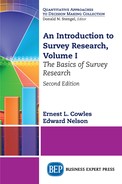Survey research is a widely used data collection method that involves getting information from people, typically by asking them questions and collecting and analyzing the answers. Such data can then be used to understand individuals’ views, attitudes, and behaviors in a variety of areas such as political issues, quality of life at both the community and the individual levels, and satisfaction with services and products, to name but a few. Decision makers in both the public and the private sectors use survey results to understand past efforts and guide future direction. Yet there are many misperceptions about what is required to conduct a good survey. Poorly conceived, designed, and executed surveys often produce results that are meaningless, at best, and misleading or inaccurate, at worst. The resultant costs in both economic and human terms are enormous.
Our purpose of writing this two-volume edition is to provide an introduction to and overview of survey research. In this volume (Volume I), we begin by introducing key elements of information gathering; specifically identifying the information needed and the best way to get that information. We then explore the importance of representative sampling and identifying and minimizing survey errors than can distort results. The remainder of the book is devoted to the practical issues to consider when developing, building and carrying out a survey, including the various modes that can be used to deliver a survey. Each chapter focuses on a key component and has an annotated set of references indicating where readers can go for more information.
Volume II focuses on carrying out the survey. After a brief overview of the importance of research questions and the research design, we discuss key elements in writing good questions. We next present key steps that researchers must go through when conducting the survey. Following this discussion, we highlight the impact of rapidly changing technology on survey research that is rapidly transforming how surveys are being constructed and delivered. Mobile communication including online access to Web-based surveys, the creation of survey panels and the use of “Big Data” present exciting new opportunities for survey research, but also present new obstacles and challenges to the validity and reliability of survey research. We conclude with an important, but often neglected, chapter dealing with the presentation of results in different formats appropriate to different audiences.
